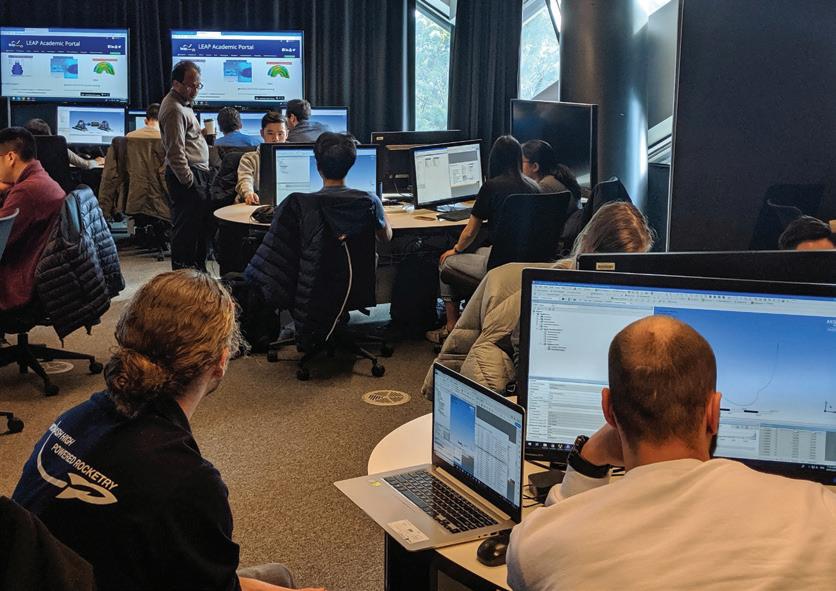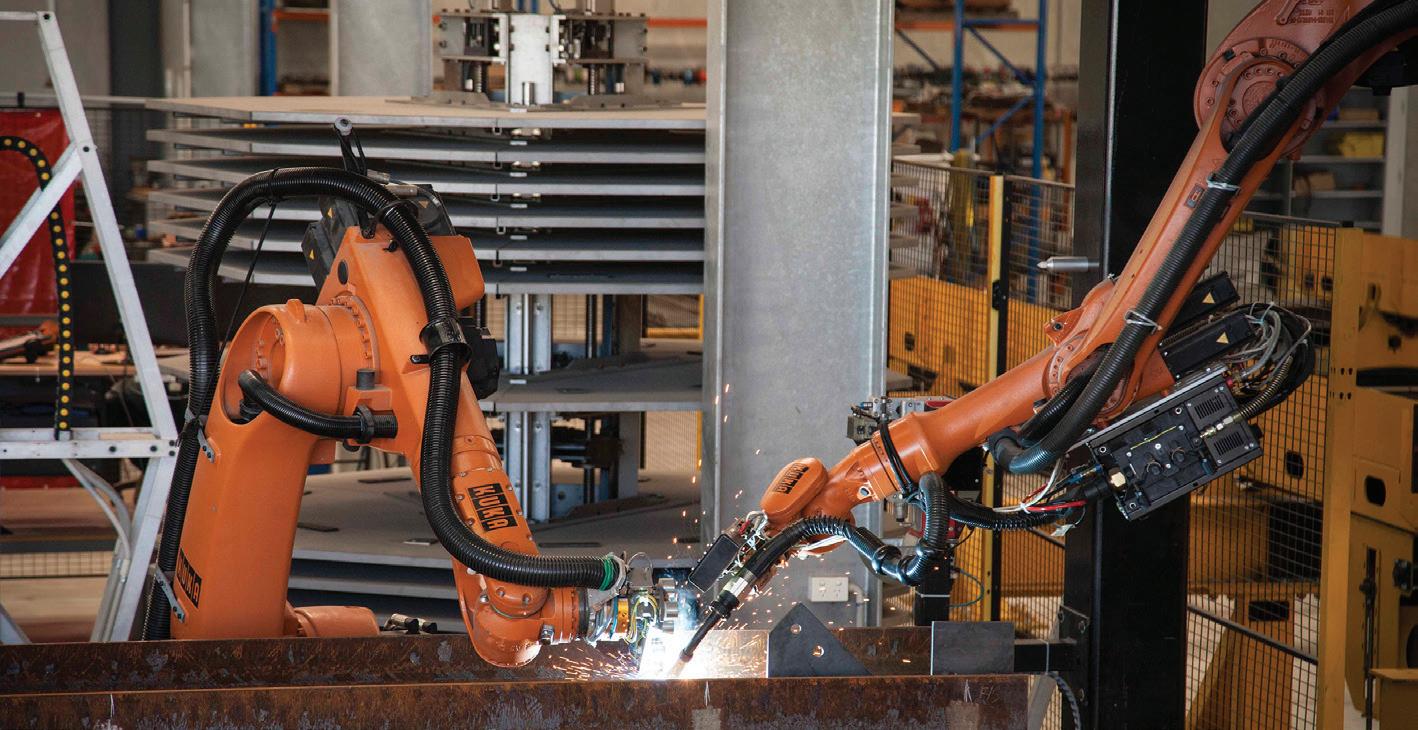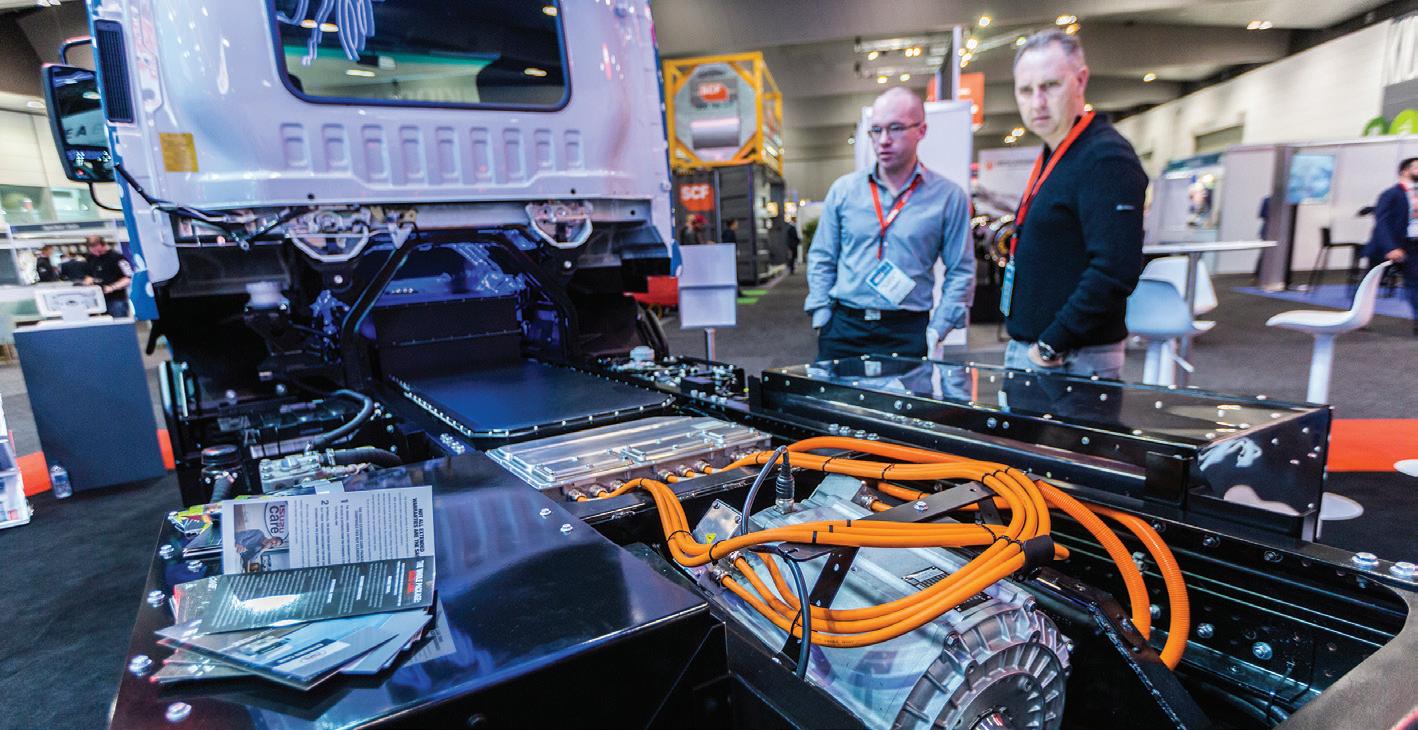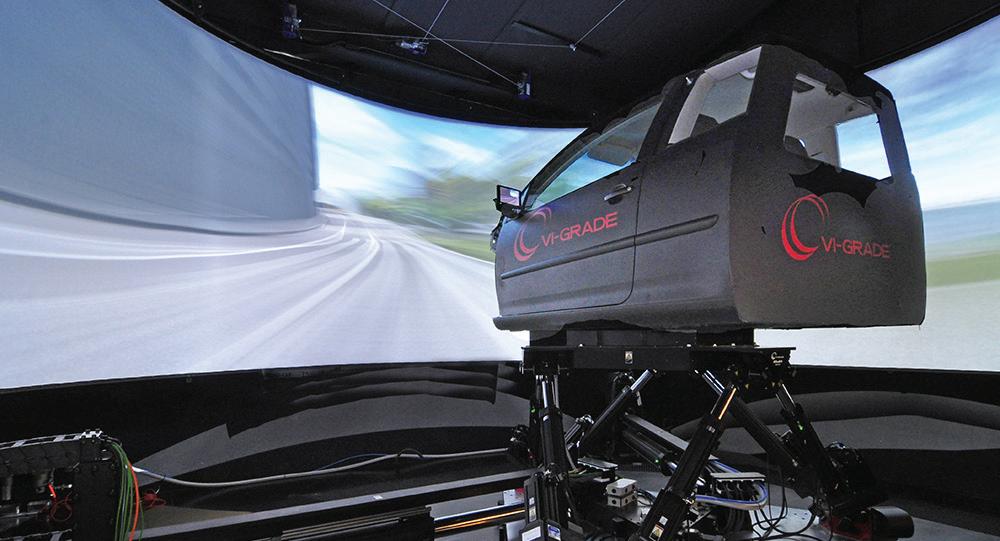
12 minute read
You’re the voice - SAE-A members have spoken
from VTE March 2020
by Possprint


The demise of Australia’s only car brand Holden is definitive proof that the Australian automotive landscape is prone to rapid and abrupt change for engineers, and as automotive companies one-by-one left manufacturing in this country it caused an upheaval that impacted greatly on the SAE-A. These factors alongside a host of other elements shattered the SAE-A however, as proof of its value and standing, the SAE-A has remerged stronger, facing the challenges of the past and present. Now it must look forward and plan for its future and the future of the vehicle engineers it represents. That’s one significant change; SAE-A now represents vehicle engineers not only automotive engineers but engineers of a range of mobility vehicles. Part of the landscape change internationally is that nowadays we talk of mobility vehicles due to the huge variations that have been introduced in that sector; there are hybrid vehicles, electric vehicles, self-driving vehicles, hydrogen powered vehicles – no doubt with more variations to come. As automotive manufacturers closed their plants in Australia engineers either retired or moved on to other fields where their engineering expertise was needed, such as truck and bus engineering, aerospace and defence, and working in niche manufacturing such as Carbon Revolution which is mentioned elsewhere in this magazine. But this diversification was difficult to evaluate hence, the SAE-A saw an immediate need to uncover the truths behind its membership; where they were, what they did and how could the SAE-A serve them better.

Over a period of months in 2019 kin8 was commissioned to research and report on these and other issues. These are the results and also the broad base of what the SAE-A will focus on in the future. Survey company kin8 conducted research with corporate members with an online survey as well as a 45-minute in-depth telephone interview, student members were each given a 10-minute in-depth interview and private members who participated were provided with the online survey and then a 45-minute telephone interview. Just over 85 members chose to be part of the survey and while reading this report on the outcomes, if it does not align with your views or if you have other input, the SAE-A welcomes your opinions and is eager to hear from you, please contact Rose D’Amicis on 0403 267 166. This is what matters to members Corporate memberships were largely renewed based on personal relationships and the SAE-A was not perceived by those members as being deeply engaged with industry, government or legislation.
“The core business of an association is to represent member groups to government and the public. SAE-A needs to address this. They used to be a peak industry body and need to rebuild that credibility.” Student members were in the most part aligned with the SAE-A due to their experience with Formula SAE-A. Not surprisingly those who did well and gained good job prospects from the competition were likely to remain positive about the SAE-A. Those who were disappointed with
their experience in Formula SAE-A were harsh critics however, they were in the minority. Students who had a positive experience and received job prospects from Formula SAE-A rated high satisfaction with SAE-A.
“The organisation and speed of completion of Formula-SAE event at Winton raceway was exceptional, which I believe was due to SAE-A’s competent batch of staff...I also appreciated the networking opportunities provided to me by SAE-A during the industry event at FSAE-A.” Private members, who were by far the largest cohort in the survey, perceived the SAE-A to be out of touch with the industry and felt underserved on issues such as technical information.
“I would value anything that gives truly behindthe-scenes information as opposed to the general information that is readily available through many other channels.” Many considered the cost of membership as high particularly those who were not based in Victoria as they would generally have to travel to Victoria to participate in events. A large number of private members have been with the SAE-A for more than 20 years.
“It’s called SAE Australasia but it’s very Melbourne centric...I’m invited to Victoria events only, but it will cost me $800 for a return fare. That’s just to attend a syllabus evening, not including meals and accommodation.” “The total cost of training courses and other events is often far too high for me and that is why I do not attend as many as I would like to. If I have to travel interstate to attend an event, I must close my business for the duration (no income) and also pay for travel and accommodation on top of the course or event costs.” Unlocking value For corporate members value can be unlocked by providing access to talented graduates as well as promotional opportunities for the corporate brand. Students who currently don’t perceive membership value beyond Formula SAE-A may be provided with opportunities to interact with corporate members, to network professionally and obtain employment. This would serve both the needs of the corporate members and students equally. Corporate members consistently seek top talent, as well as the development of their employees, which SAE-A is well placed to facilitate. For corporate members the SAE-A can also provide advocacy services and a united voice to speak to the concerns of industry with state and federal government. Formula SAE-A remains a key event of interest of corporate members for talent acquisition.
www.saea.com.au From L to R: SAE-A board members Kin Cheong, Adrian Feeney, Michael Waghorne, Greg Shoemark
However, they said they did not receive opportunities to interface with SAE-A and potential recruits outside of the annual event. “We attended Formula because it gave you access to engineers who had been through a good life experience, you got to see the good engineers.” Many private members were introduced or encouraged to join SAE-A through their workplace; either via word of mouth from colleagues, employers or the company’s corporate membership. SAE-A can unlock value for those members by providing unique technical information and training that would otherwise be difficult to obtain. Private members early in their career sought advantages to differentiate themselves through gaining access to the latest industry updates and being part of an industry recognised association. SAE-A is well placed to connect graduating student members with private members at events or through mentoring, to guide their SAE-A membership evolution. Beyond Formula SAE-A, many students did not see any benefits of staying an SAE-A member as they started their career. Here the SAE-A can unlock value for student members by demonstrating relevance as a source of technical expertise, upskilling, industry networking and professional development. The SAE-A is in the position to be the source of current and emerging technical industry information, it can provide professionals with unique knowledge, qualifications upgrades and employment opportunities and the society must leverage those advantages more fully in the future. The overarching reason private members joined SAE-A was for access to technical industry information via events, seminars, site tours and research papers. Private members also sought to be part of an industry recognised member association, which offered professional development opportunities.


Another important reason for joining the SAE-A was also considered to be part of an industry recognised association and identified in the engineering community as an engineer. One of biggest opportunities that was apparent in the survey was the chance to offer access to members of technical standards and research papers, as well as highlighting industry trends, legislative ruling and advances in technology. Further to that, opportunities to attend industry events and seminars, site tours and networking were high on the agenda.

SAE-A was seen to have positive potential for a role in relation to qualification authentication and upgrades.
“Qualification authentication would be good, especially in helping to recognise people without certification...trade schools don’t help enough with qualifications and a lot of trade qualified people would study part time to expand their skill set.” Where to from here For private members it appears from this survey that the vital area of urgent action is to provide more access to technical standards and research papers, updates on industry trends, legislative rulings and advances in technology. In the longer term the SAE-A is to rebuild its reputation and credibility collaborating more with academics and corporate partners. To provide more opportunities for knowledge exchange and consider more online platforms for communication such as webinars. Corporate members were particularly interested in representation to government on legislative impacts of proposed legislation. And developing the connections between graduates and companies.
“I spend a lot of money getting in front of ministers. We need more of this, SAE-A would be well placed but it’s hard, takes time and no one really wants to do it.” Another prime area of importance to corporate members was that SAE-A should act as an industry connector not just with students but between corporate members identifying potential synergies via events and networking and providing access to technical research and conference papers that are typically difficult to access. It was also suggested that the SAE-A annual awards night be reinstated to recognise industry innovation and reconnect with major industry players which could include government. Corporate member companies could be better engaged through more frequent satellite events throughout the year. For example, this might be an educational workshop or a smaller scale physical or virtual competition. SAE-A should provide accessibility to these events nationally. Corporate member companies could be given additional sponsorship opportunities, such as offering product or service discounts, insurance and other such offerings that would be exclusive to SAE-A members. In the eyes of student members, Formula SAE-A was their main experience with SAE-A, and it was perceived as an isolated annual event. However, there was a perceived need in students to interact more with SAE-A both before and after the event, this was seen as being of real value to them. Students sought to leverage Formula SAE-A



as a means for gaining employment. There is a greater opportunity for SAE-A to facilitate job opportunities between students and industry employers. Where are we now? There is no doubt that the past 10 years have been hard on SAE-A; from external sources such as the shutting down of large-scale automotive manufacturing in Australia and equally from internal issues that forced the association into voluntary administration.
“I would get back to SAE-A and be involved if I could see they had a specific direction. The society used to be stronger and more relevant, but it has allowed itself to slide in the last 10 years. It’s a hard place to come back from.” After working for several years on reestablishing the operational base of the SAE-A, without which it would not have been possible to continue with any work, the board took the next step of surveying its members. This step was taken as a precursor, it was a weathervane to show the direction that members wanted to take for the future. Now the SAE-A will begin to put into practice the recommendations that were put forward in this survey. As members please continue to provide feedback but also avail yourselves of the offers put forward, of the events organised and give of your knowledge and experience. “I sincerely thank all those members who took time to contribute to this survey and provided such good feedback,” Adrian Feeney said.

Simcentre portfolio has a new Star Siemens Digital Industries Software has released Simcenter STAR-CCM+ software as part of the Simcentre portfolio of simulation and test solutions that helps optimize design and deliver innovations faster and with confidence.
The latest release of Simcenter STAR-CCM+ includes major enhancements to improve simulation time and accuracy as well as enhance collaboration, giving customers a comprehensive digital twin to help drive highly predictive simulations. Siemens has included a completely new parallel polyhedral mesher for faster, more effective meshing, as well as the industry’s first model-driven adaptive mesh refinement (AMR) solution. The latest release also includes automatic coupled solver control for reduced set up time while improving convergence speed and the industry’s first ever collaborative virtual reality (VR) feature in a CFD code for enhanced team collaboration on simulation results.
To keep up with the competition and achieve the next innovative breakthrough, faster and more reliable simulation results are critical. The latest release of Simcenter STAR-CCM+ offers a fully rewritten next generation parallel polyhedral mesher. Using parallel performance, it meshes build up to 30 times faster than in serial, providing a consistent mesh regardless of the cores used and a more effective mesh distribution with the same accuracy and robustness.


New adaptive mesh refinement (AMR) technology is the industry’s first model-driven AMR, which intelligently refines the mesh based on the physics. This can lead to less user interaction as well as computational overhead and reduces overall mesh size. Automatic solver controls dramatically improve the ease-of-use and robustness of the coupled solver. This delivers faster convergence to solution giving users additional speedup for all flow regimes straight out of the box. Collaborative VR in Simcenter STAR-CCM+ allows teams across the globe to interact in the same immersive virtual environment in real time, enhancing communication and speeding up decision-making. Multiple VR clients can now be connected and synchronized to the same simulation, with avatars showing the location of other users and providing the ability to tether users to get the same experience. Simcenter STAR-CCM+ is an integrated solution for computational fluid dynamics (CFD) and multiphysics simulation that brings automated design exploration and optimization within the grasp of all simulation engineers.
The new Tomelleri Mercury 1.8 metre 6-Axis Measurement Arm senses discrete points on the surface of the object with a probe. The dimensions are immediately digitised and transferred to a CAD system, where surfaces are developed and drawings are finalised. The new Mercury model features a counterbalance system that makes the arm ergonomic and easy to use. The counterbalance system also means that a user doesn’t need to affix the arm to a table surface just place it on a sturdy table top or solid interface like a steel or aluminium base with three support points and it is ready for use. This makes it ideal for organisations that need to complete metrology projects on the go. No need to take your part into a metrology lab, with Tomelleri you can take the metrology lab to the part. The Mercury is thermally compensated, meaning it is able to maintain its high degree of accuracy regardless of temperature change throughout the day. Available in both 1.3 metre and 1.8-metre models, the Tomelleri Mercury Measurement Arm works with a number of leading software platforms, including Aberlink and the Geomagic suite. Mercury metrology measuring arm A new European-made metrology arm for measuring the geometry of physical objects has been released by Leussink Engineering.


